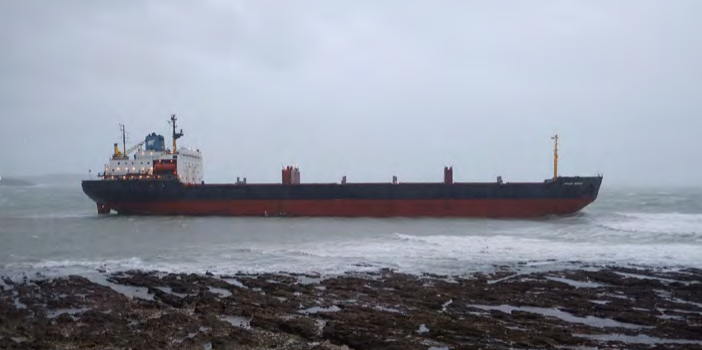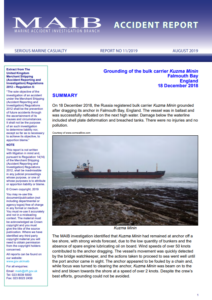The UK MAIB issued an investigation report on the grounding of bulk carrier ‘Kuzma Minin’ in Falmouth Bay, in December 2018. The report highlights the unexpected pressures caused during salvage efforts due to the vessel’s lack of P&I insurance.
Although the movement towards the shore was quickly detected by the bridge watchkeeper, the actions taken to proceed to sea were interrupted by the anchor becoming fouled by a discarded length of anchor chain. As focus was turned to clearing the anchor, Kuzma Minin was blown towards the shore at a speed of over 2 knots.
The incident
Kuzma Minin sailed from Terneuzen, Netherlands, on 7 December 2018 following a 71-day PSC detention. The master notified the owner that Kuzma Minin had insufficient bunkers and engine lubricating oil (lube oil) for the intended passage in Cueta.
Between 10 and 14 December, Kuzma Minin alternated between being at anchor and loitering at slow speed off Cornwall, England, until approval was given for the vessel to take bunkers in Falmouth.
On 15 December, Kuzma Minin shifted 4.3nm from an anchorage east of the Manacles to an anchorage in Falmouth Bay, within Falmouth harbour’s limits.
During the evening, a bunker barge delivered 30t of marine diesel to Kuzma Minin, but because of MSCO’s unpaid debts from previous ship visits to Falmouth, the supplier had required payment before delivery.
No oil was delivered on 17 December and the master opted to remain at anchor overnight, but he was aware that the weather forecast predicted southerly winds up to Beaufort force 8.
He wrote in his night orders ‘for wind speed in excess of 16 to 17m/s [31-33kts], the main engine should be at immediate readiness’.
At 2100, the second officer took over the bridge anchor watch, and in view of the increasing wind speed soon ordered the duty engineer in the engine room to ensure that the main engine was at immediate readiness.
By 0400 the following morning, when the chief officer took over the bridge watch, the southerly wind was gusting over 52kts, the sea swell was between 4m and 5m, and Kuzma Minin had began to yaw.
At 0425, the vessel started to drag its anchor to the north. The chief officer was alerted by the anchor watch alarm sounding on the electronic chart system (ECS) and saw that the vessel’s speed was 1.4kts. He called the master to the bridge, advised the engine room, and informed the rest of the crew via the tannoy system.
Kuzma Minin’s master arrived on the bridge and immediately ordered the bosun to go to the fo’c’sle and heave in the anchor. He also informed Falmouth port, via VHF radio, that the vessel was dragging its anchor and that he intended to proceed to sea.
An attempt to clear the chain by dropping the anchor and heaving it in again was unsuccessful.
At 0510, Kuzma Minin was approximately 6 cables off Gyllyngvase beach on a heading of 274° and making over 2kts leeway to the north.
Five minutes later, the master assessed that Kuzma Minin would not clear Pennance Point, which was only 0.5nm to the west, and stopped the engine.
At 0519, Kuzma Minin was within 2 cables of the shallows and the master ordered the bosun to let go the port anchor. He did so, but the anchor again did not hold, and Kuzma Minin grounded on Gyllyngvase beach at 0525.
The predicted low water (1.8m) was at 0730 and, as the tide ebbed, the vessel settled on a heading of 222° with a 5° port list. Its stern was lying on sand and its bow across a rocky ledge.
The master informed Falmouth port and MSCO of the situation. Falmouth’s harbourmaster used local resources to refloat the vessel, but concerns over Kuzma Minin’s lack of P&I insurance cover, and its owner’s lack of co-operation in appointing a salvor, caused unexpected pressures.
Conclusions
- The low quantity of bunkers and the absence of any reserves of lube oil onboard Kuzma Minin influenced the master’s decision to remain at anchor on a lee shore when strong winds were forecast.
Nonetheless, that Kuzma Minin’s master understood the risks of remaining at anchor are indicated by his actions to ensure that the bridge watchkeepers were alert to the possibility of the ship dragging, the use of an anchor swinging circle on the ECS, and having the main engine ready for immediate use in winds stronger than 17m/s,
…the report reads.
- The anchor dragged due to the wind speed increasing to over 50kts, Kuzma Minin’s in ballast condition, and the sea swell.
- The vessel’s movement was detected quickly, and the actions taken to put to sea were progressing until a chain was seen fouling the port anchor as it broke the sea surface.
- As the vessel’s leeway towards the north increased to over 2kts, the attempt to clear the port anchor was unsuccessful, and the master was unable to turn the vessel away from the shore.
The master’s decision to weigh anchor and sail was prompt, and his use of the main engine checked Kuzma Minin’s movement towards the shore as well as taking the weight off the cable as the anchor was heaved.
- In the absence of a salvor and support from Kuzma Minin’s owners, Falmouth harbourmaster was unclear how the response arrangements identified in the NCP could be implemented, which prompted repeated requests for the SOSREP to intervene.
- The SOSREP had assessed that there was not an immediate threat of pollution and, in accordance with the NCP, he tacitly approved the response of Falmouth harbour’s operation to recover Kuzma Minin from Gyllyngvase beach. However, early clarification of the SOSREP’s position would have been useful to the harbourmaster.
- Falmouth harbourmaster’s co-ordination of the refloating operation was effective, but Kuzma Minin’s lack of P&I insurance led to unexpected pressures, notably concerns over responsibility for payment which hindered the appointment of salvage experts and the ability to secure the services of appropriate assets.
Lessons learned
- The financial situation of the Murmansk Shipping Company meant that Kuzma Minin’s master was unable to replenish bunkers and lube oil which influenced his decision to remain at anchor on a lee shore when strong winds were forecast.
- Kuzma Minin’s lack of P&I insurance led to concerns over responsibility for salvage payment which hindered the appointment of experts and the ability to secure the services of an additional tug that was on passage nearby.
Actions taken
Falmouth Harbour Commissioners has:
- Identified that the duty harbourmaster should consider requiring bunker vessels that extend their stay to re-anchor further offshore if severe weather is forecast.
- Reviewed its procedures for checking vessels’ P&I insurance and introduced additional checks for vessels meeting certain criteria.
- Met with and exchanged correspondence with the UK government’s Shipping Minister regarding the implementation of the NCP with a view to achieving greater clarity on the management of future incidents.
Recommendations
JSC Murmansk Shipping Company is recommended to take steps to ensure that its vessels are adequately resourced to operate safely and in accordance with international conventions, taking into account the potential consequences of vessels having insufficient fuel and oils, and the statutory requirement to maintain P&I insurance.
Explore more herebelow:
See more:































































